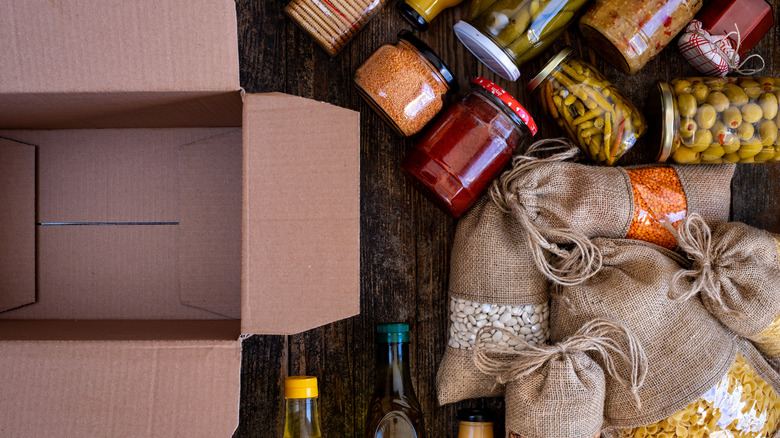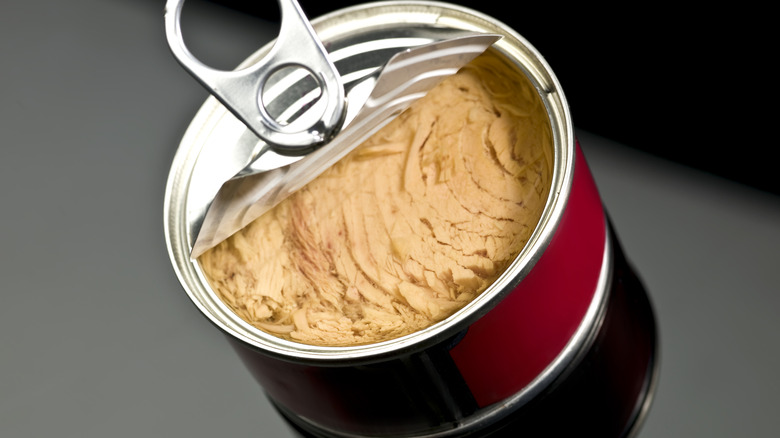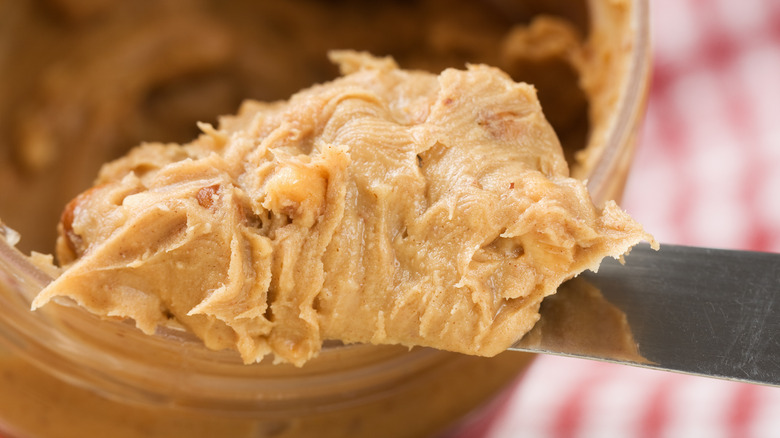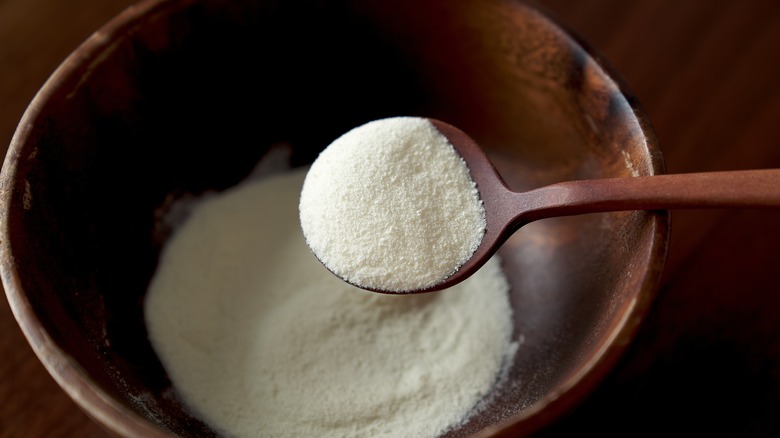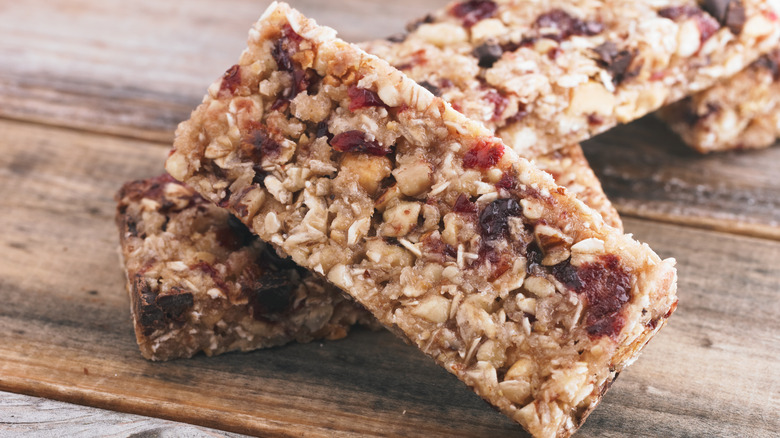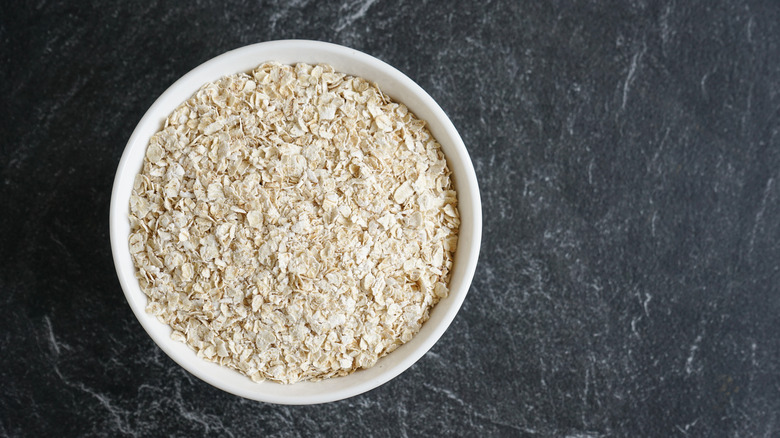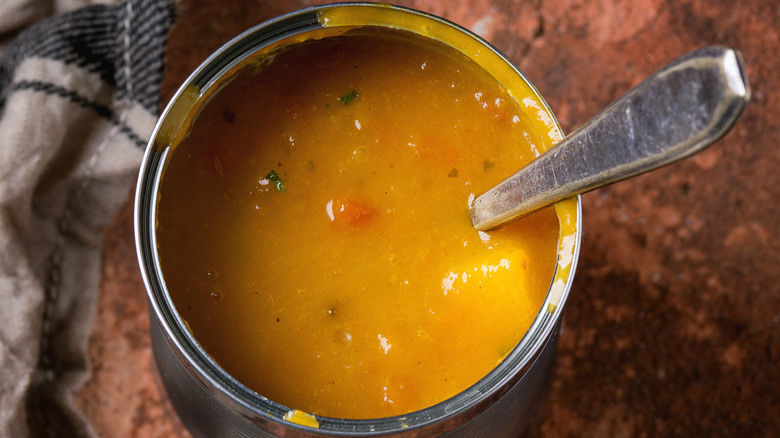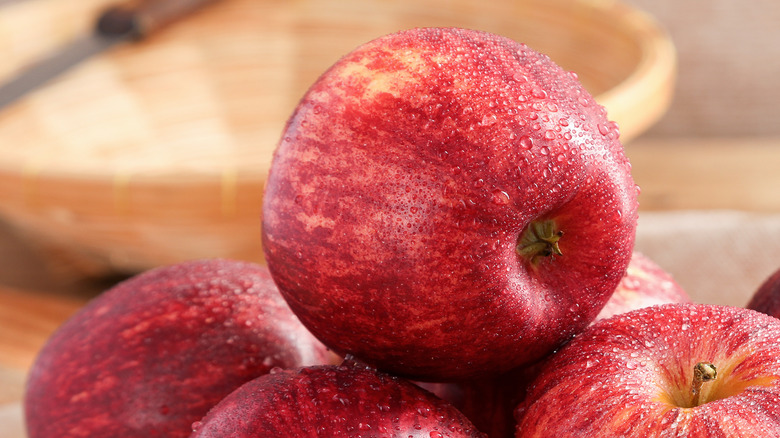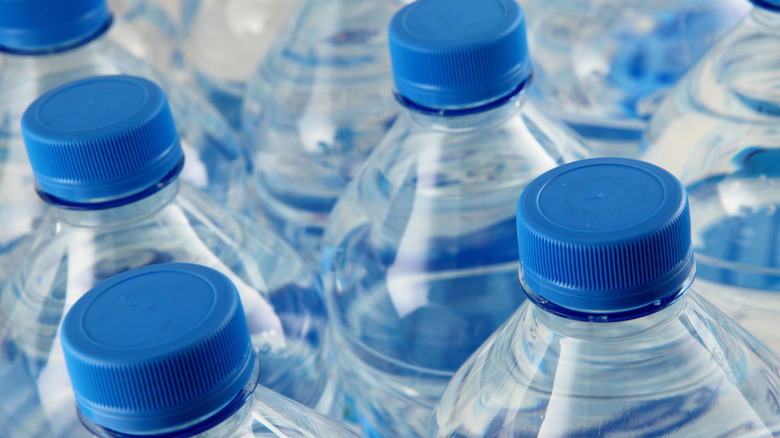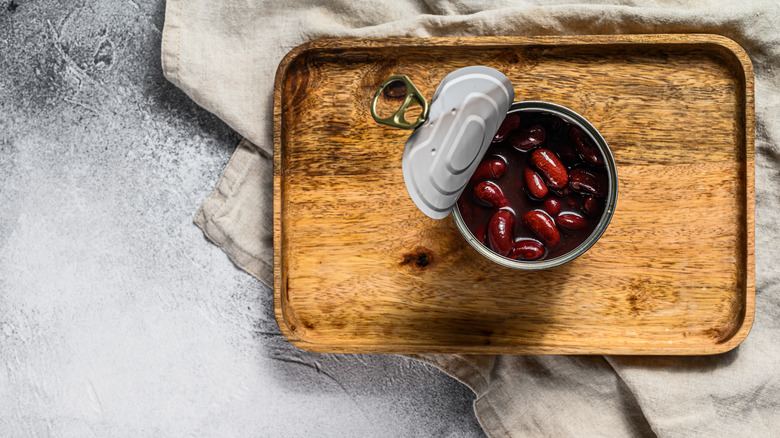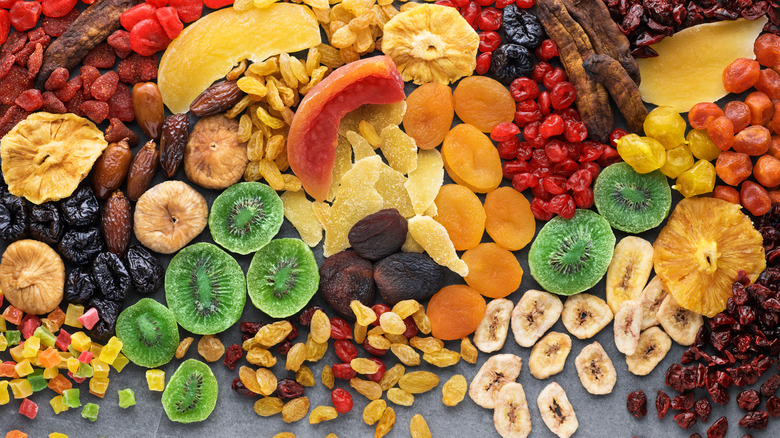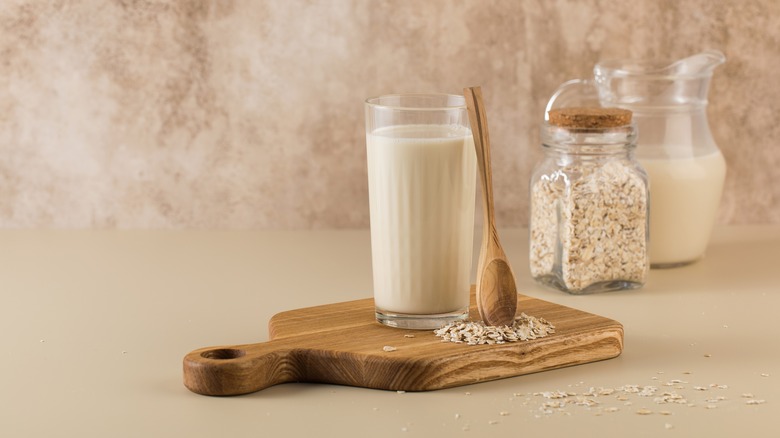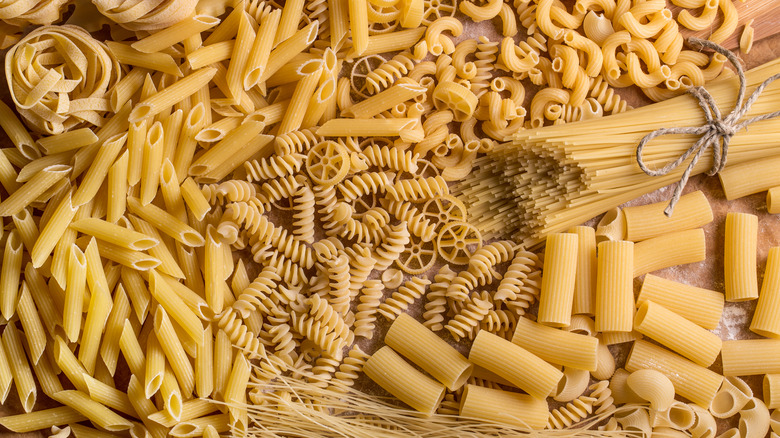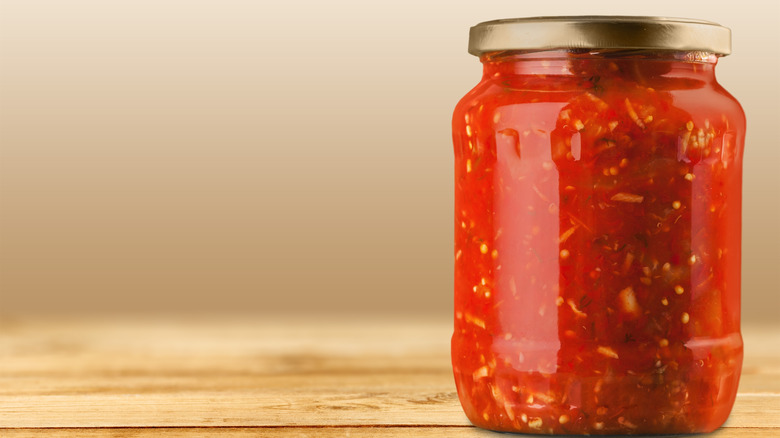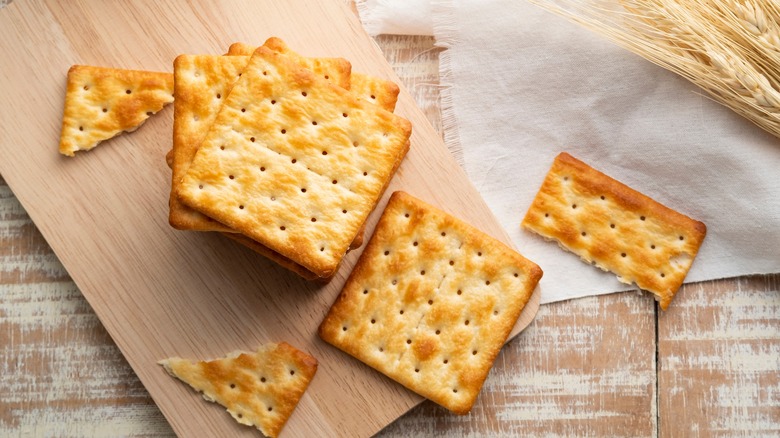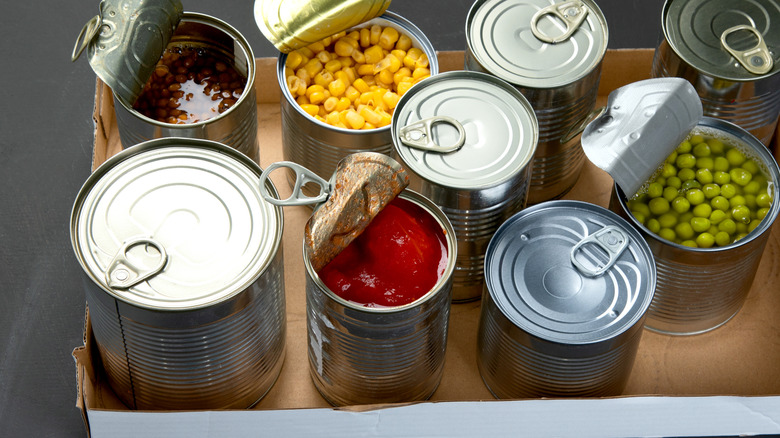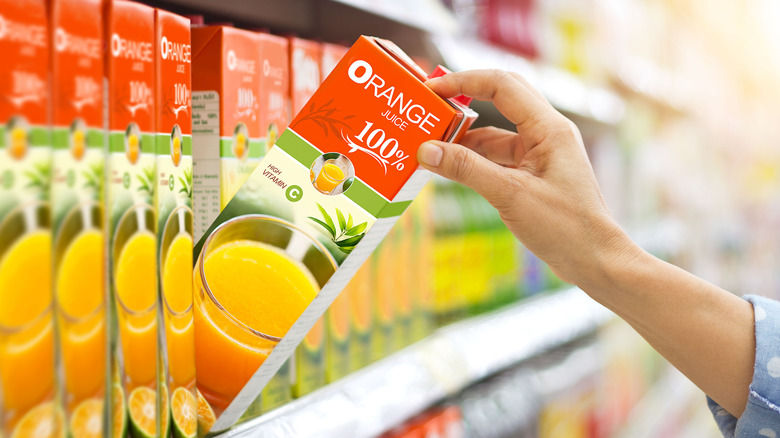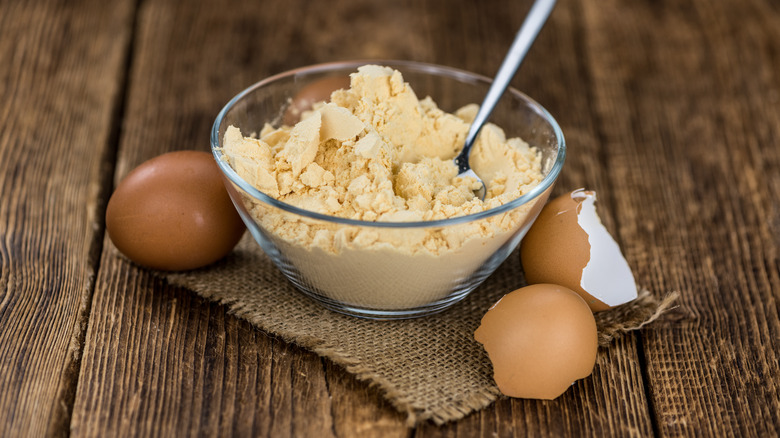17 Foods To Stock Up On Before A Hurricane
When a hurricane arrives, it's of the utmost importance to be prepared. And that preparation should start long before the weather turns. Although hurricanes are usually more predictable than other types of extreme weather, you may still only have a window of a few days to ensure that you have everything you need, and ensuring that you have safe shelter and necessary provisions is vital.
And thinking about food should be one of your top priorities. During a hurricane, your ability to cook and prepare food in the usual manner will likely be impacted, and you probably won't be able to get to the store to stock up on goods. As such, it's imperative to curate a thoughtful food store, with non-perishable items that don't require a huge amount of preparation. But, it's also important to make sure that the food you're purchasing and storing is interesting, tasty, and nutritious. During a hurricane, food can be a comfort and salvation, and the last thing you want is to end up stuck with an uninspired menu, devoid of nutrition. But, when space for storage is limited, which are the foods you should prioritize stocking up on?
1. Canned tuna
Power outages can occur during a hurricane, and while you may be able to replace it with a generator, the likelihood is you'll not have a huge capacity for cooking meals from scratch. This can make meals with proteins that need cooking (like fresh chicken, beef, and pork) tricky. That's where canned tuna comes in. This precooked protein has an incredibly long shelf life, with some cans being able to last up to five years or more. It's incredibly versatile, easy to prepare, and is particularly well-suited to being used with other shelf-stable ingredients you can keep in your storage, like mayonnaise, mustard, and hot sauce.
Canned tuna is also one of the most nutritious things you can stock up on. As well as being high in protein, with over 32 grams per 100-gram serving portion, it's also low in fat when packed in water. Tuna is also full of useful nutrients like vitamin B3 and magnesium, which both help to keep your nerves and nervous system healthy (per BBC Good Food). Bear in mind that canned tuna can be slightly high in sodium, so you may not need to add much more salt if you're using it in a recipe, as your food may end up tasting too briny.
2. Peanut butter
Peanut butter is one of the most efficient foods you can keep for when a hurricane comes. A plant-based protein source, peanut butter will stay safe for consumption for several months if the jar is unopened, and will remain perfectly fine to eat once opened too. Natural and commercial peanut butter can differ considerably in how long they stay fresh, with natural peanut butter generally going bad more quickly — but it will still last for up to a month without being refrigerated.
Peanut butter is also high in unsaturated fat and fiber, and combined with its protein, that can make it pretty filling. One of our favorite things about it is how easy it is to use in meals or as part of a snack, in both savory and sweet applications. Spread it onto a cracker or some bread with some grape jelly to make a classic PB&J, or mix it with a little soy sauce and sriracha to make a dipping sauce or dressing for a bean salad. You can also add a spoonful or two to some instant ramen, both to level up its flavor and to make it more satisfying.
3. Powdered milk
Access to the fridge can be in short supply during a hurricane. And even if you can reach your fridge, if it has no power, the food inside will generally only stay cool for around 4 hours or so before it starts to warm up. This makes food that needs to be chilled, like fresh milk, tricky to carry on using.
But, powdered milk is an excellent alternative. It's made by spray-drying pasteurized milk until it loses all of its moisture, leaving just the dry milk solids behind. These solids can then be rehydrated when you add water. As nothing is stripped away except for the water content, powdered milk remains just as nutritious and good for you as fresh milk, with the same levels of vitamins and protein. The spray drying also improves its lifespan: Powdered milk can last for several years if it's unused, and up to three months after it's opened.
Powdered milk is also a great choice as it tends to be cheaper than both fresh milk and UHT milk. And, while UHT milk already comes in liquid form, once you open the carton, it will start to go bad pretty fast, especially if it's not refrigerated. With powdered milk, on the other hand, you can simply use as much as you need.
4. Breakfast bars
Breakfast bars are your best friend during a hurricane. These individually-portioned items take up barely any storage space, and as they usually last for 6-8 months, you can stock up on them well in advance. These bars are particularly useful as you can eat them both as a no-fuss breakfast, and as a snack, and you can also crumble them up and mix them with some nuts and dried fruit for a homemade trail mix.
Bear in mind, though, that breakfast and granola bars can differ considerably in terms of their nutritional values. And some that seem to be healthier may actually be full of sweeteners, with certain brands putting over 20 grams of sugar in each bar. Ideally, you should be looking for a bar that has less than 15 grams of sugar and is high in fiber and protein. Both the fiber and protein will help to keep you full while you're waiting out the storm, and the fiber will have the added benefit of counteracting any blood sugar spikes and keeping your digestive system working healthily (via the Harvard T. H. Chan School of Public Health).
5. Instant oatmeal
When your access to the kitchen and all its cooking facilities is limited, making a nutritious breakfast can be tricky. And it's all too easy to fall back on breakfast cereal which, while tasty and convenient, can sometimes have as much sugar as candy. But, you can avoid this by grabbing some instant oatmeal. These quick breakfasts come in individual packets, can last for up to 2 years from the purchase date, and can be made by simply adding boiling water or milk and stirring.
As well as this, instant oatmeal is pretty good for you. While you might assume that the processing to make instant oatmeal strips it of its health-beneficial attributes, the oats only lose a small amount of nutrients. As such, it's still high in B vitamins, vitamin A, minerals like phosphorus and magnesium, and fiber.
What's more, instant oatmeal often comes with flavors added, removing the need for complicated recipes (although some of those additives may be high in sugar, so make sure you're checking the label if you want to keep things healthy). If you're just buying the plain version, though, instant oatmeal lends itself to being made more interesting with a range of shelf-stable items that you can keep in your food store, like peanut butter, cinnamon, and dried fruit.
6. Canned or instant soup
Things don't get more simple than canned and instant soup — and during a hurricane, simple is what you need. Both canned and instant soups are perfect for when food preparation capacity is low, and require no more than a microwave or a kettle respectively to prepare them (and if you're really in a pinch, canned soup can be eaten cold). They often don't need much added to them, either. Even the simplest canned tomato soup can be delicious, and if you can find a brand that's low in sodium, it won't be too bad for you.
Having said this, it's useful to remember that canned soup can also work as a superb base for other easy-to-store ingredients. Mix some canned vegetables with your soup for some extra fiber and vitamins, or some canned beans for added protein. If you can cook pasta, you can combine this with some cream of chicken to make a quick chicken noodle soup. Canned proteins like chicken or tuna can also go well in soup and make it more satisfying. And, if you have some croutons or any breadcrumbs to hand, scatter them on top for some extra crunch.
7. Apples
It can be difficult to keep fresh produce edible during extended periods without power, and this can lead to people falling back on canned, preserved, and processed items to keep them full. But while that may be convenient, it might also not be the most nutritious approach. Heavily processed foods can often have ingredients added to them to make them last longer, but these ingredients (like sugar, salt, and fat) can also have an impact on your health if eaten in high quantities, and they may also be low in vitamins, minerals, and fiber.
So, instead of reaching for processed foods as a snack, grab an apple. Apples are fairly unique amongst fruit because they last a surprisingly long time when kept in a cool, dry location. Some varieties, like Red Delicious and Chieftain, can stay edible for up to six months. Apples are also rich in fiber, with the pectin in them helping keep digestion healthy (per WebMD), and they also have a good amount of vitamin C.
It's useful to bear in mind, though, that while apples can last for a while, some varieties will go bad sooner (like Lodi apples, which will only stay fresh for a few weeks), and exactly how quickly an apple rots can vary considerably from fruit to fruit. As such, make sure you're not buying and putting them in storage too early.
8. Bottled water
While some hurricanes may leave water supplies unaffected, in the worst-case scenarios, they can reduce or stop your access to fresh water for a considerable amount of time. Given that you need water for hydration, cooking, cleaning, and using the bathroom, having a sufficient supply of it is essential. As such, the Federal Emergency Management Agency (or FEMA) recommends buying commercially bottled water and keeping it sealed until use. You should have a two-week supply minimum for each family member, allowing for 2 quarts minimum per day (plus more for hygiene purposes and cooking, and if it's especially warm) — and in an ideal world, more than that in case of any issues.
The most important thing when it comes to bottled water is to make sure it's well within the expiry date and that the containers are well-sealed. But beyond that, there are other choices you might want to consider. Opting for glass bottles or unlined cans of water will be best for the environment — and avoid paper packaging. "It's the worst because it looks great from the outside, but these boxes are made from lots of different layers of material, including plastic," says Mineral Water sommelier Martin Riese, via Eater. As such, they're usually not recyclable. For the best freshness and taste, opt for a brand that uses a spring, mineral, or glacier source, and avoid anything that's branded as "purified" — it's really just glorified tap water.
9. Canned beans
Honestly, it doesn't get much better than canned beans. These food items are a must-have in your hurricane store, thanks to their long lifespan and premium nutrition. Canned beans can last several years from the moment of purchase without any decline in quality, and will often last way longer than that. Once opened, though, they should be consumed pretty quickly, especially if you don't have access to a refrigerator, where they'll last 3 to 4 days.
Beans are super-high in fiber and protein, meaning that they're both filling and an excellent protein source for people following plant-based diets and meat-eaters alike. They're also rich in key minerals like magnesium, potassium, and B vitamins. If they're just packed in water, they'll tend to be low in sodium, although keep an eye on the sodium count of certain brands. Above all, canned beans are a way to make virtually any quick meal better. Black beans, which have a nutty, slightly savory taste, are great stirred into some instant rice for a satisfying lunch or dinner. Canned baked beans, on the other hand, are awesome for an easy breakfast. Or, combine a few cans of beans with some shelf-stable dressing for a quick bean salad.
10. Dried fruit
Alongside your main meals, you'll also need to ensure you have a healthy supply of snacks in your hurricane storage. And dried fruit is one of the best snacks you can stock up on. Dried fruits, whether homemade or store-bought, can last for up to a year, thanks to the lack of moisture limiting the ability of microbes to grow and spoil it. Dried fruit is also nutritious and full of all the same vitamins and minerals that fresh fruit is (although be wary of certain brands, which may coat their fruit in sugar or include additives or preservatives to make their products last longer).
Dried fruit is also an awesome way to get hands-on with your hurricane preparation, especially with your kids. Pretty much any fruit can be oven-dried, and it's a particularly good way to make use of any fresh fruit you might not be able to get through. All you have to do is slice up your fruit, and place it in a low oven for several hours, before allowing it to cool completely and air dry. Then, place it in a sealed mason jar or Tupperware container, and pop it in your storage.
11. Plant-based milk alternatives
Nutritious staples like milk are essential for hurricane food stores, both as a tasty alternative to water and to add to coffee, tea, and cereal. And, there's no reason why people who have a plant-based diet shouldn't get in on the fun. Plant-based milk alternatives like soy milk, as well as oat and almond milk, often come in shelf-stable cartons with a pretty long lifespan. All of them can last several months at room temperature when unopened.
These products often come in large crates, making it easy and cost-effective to stock up if you get through cartons quickly. And, even if you're not plant-based, they're still a great choice for their lifespan, their taste, and their health benefits. Almond milk is a particularly good source of vitamin E, a nutrient that's especially good for your eyes, particularly to reduce the onset of age-related macular degeneration (per the Harvard T. H. Chan School of Public Health). These milk alternatives are also often fortified with additional vitamins and minerals, with oat milk and almond milk both frequently containing vitamin D, which could be useful if you don't have access to direct sunlight during a hurricane.
12. Pasta and rice
If you're compiling a hurricane food store, you have to include pasta and rice. These staples are arguably the easiest and longest-lasting form of carb you can choose, taking up little space and offering significant energy density for their size. Dried pasta and rice can form the base of countless meals, and are incredibly cost effective.
When picking pasta and rice, though, it's worth thinking about how easy it'll be to prepare the type you're buying. Things like brown rice or particularly thick pasta shapes might be satisfying, but they can also take way longer to boil, and if you have a limited energy supply, you'll want to preserve as much as possible. As such, we'd advise going for types that cook quickly, like Minute rice or angel hair pasta. A few packs of couscous (which is a type of pasta, and not a grain) can also be an excellent purchase, as you don't really need to cook it at all, other than adding some boiling water and allowing it to soak.
While we'd always recommend combining your pasta or rice with a solid protein like tuna or beans and any canned vegetables you have to hand, in a pinch it can make a tasty meal with minimal additions. Place some jars of pesto and some soy sauce in your food store, for pasta and rice respectively. Nutritional yeast, which can last for up to two years at room temperature, can also make a great parmesan replacement.
13. Jarred pasta sauce
The last thing you want is to have to scarf down plain pasta during a hurricane, for days on end. That's why keeping jarred pasta sauce on hand is a must. This long-life item is a quick way to make a complete meal for the family, and there are loads of different flavors and variations out there, to keep things interesting. Jarred pasta sauce can also be easily augmented with other store-cupboard ingredients like dried herbs, olive oil, or garlic powder.
Jarred pasta sauce can be used for way more than just pasta, too. Tomato-based pasta sauces can be used as a dip for tortilla chips or a spread for sandwiches. Just remember that once opened, these products can go bad fairly quickly, especially if you don't have access to a refrigerator — so it's best to use them in one go.
Additionally, jarred pasta sauces, particularly tomato-based ones, are especially prone to being high in sugar and salt. This improves the product's tastes, but it can also make them unhealthier. Try to find options that are lower in sodium and added sugar while still being flavorful.
14. Crackers
You may well find that crackers are your best friend during a hurricane. These dry, flat, crunchy morsels have their origins in hardtack. This simple flour-based cracker has been made and may have even been consumed for over 6,000 years by soldiers and sailors alike and has long been prized for its portable nature and ability to last for ages without going bad. As such, it's a perfect way to make sure you're consuming carbohydrates without having to resort to fresh items like bread, which can start to grow mold pretty quickly.
Crackers can be used in a huge number of ways, and their neutral flavor means that they suit both savory and sweet uses. As well as being a simple snack on their own, they can play host to an infinite number of toppings. You can also crumble them and use them to top canned soup or pasta. And to create a cozy feeling while you wait out the storm, you can't get much better than making classic S'mores. Graham crackers, milk chocolate, and marshmallows are all items that will last for a while in your food store, and all you need is a portable stove.
15. Canned vegetables
It's crucial to keep an eye on your nutrition, even when less-than-ideal weather strikes — and this becomes even more important if it looks as though you're going to have a long wait in your shelter. So, stocking up on canned vegetables is a must. Canned vegetables are comparable to both fresh and frozen varieties nutritionally (although there can be a slight loss of certain vitamins due to the canning process). Once canned, they can last for up to 5 years, although use-by dates may vary from brand to brand.
There's a huge variety of canned vegetables to choose from, and it's a good idea to diversify as much as possible, to ensure that you're getting as broad a range of nutrients and tastes as you can. You can either eat them as a side to your main meal or use them to add extra bulk and flavor to a dish like soup. Importantly, while some vegetables are canned with just water, many others have sodium added, to make them taste better and to preserve them for longer periods. Try to pick vegetables that have no sodium added, so that you don't have to waste any of your bottled water rinsing them.
16. Fruit juice
You may not have access to fresh fruit during a hurricane, but fruit juice may be the next best thing. Long-life fruit juice can stay fresh at room temperature for up to a year if unopened, thanks to it being pasteurized, which kills off any microbes. While it can be high in sugar and some varieties can contain additional preservatives or additives, fruit juice can also be high in vitamins and minerals like vitamin C and potassium, and will likely be a better way to get your sweet fix than relying on candy. Some fruit juices, like orange juice with the pulp still included, can also contain useful fiber.
Fruit juice can make a nice change from bottled water, although because of its sugar content, we'd recommend not subbing it in too often. While you don't need to necessarily add anything to fruit juice to enjoy it, if you're in the mood to get all fancy, stock some shelf-stable syrups and club soda alongside it, to make some hurricane mocktails. If you're in the mood to theme your drinks to the weather outside, you could even make a twist on the classic Hurricane cocktail. Omit the alcohol to keep a clear head and allow every member of the family to take part.
17. Dehydrated eggs
Finding protein sources to stock during a hurricane can be tricky, especially those that are suitable for breakfast. And, that's why dehydrated eggs could be your best friend. Powdered and dried eggs have been around for a while, and became very popular during World War 2, particularly in Britain where they filled the gap left by egg rationing. To produce them, the eggs are spray-dried or freeze-dried, removing all of their moisture and leaving concentrated egg solids, which are then further broken down.
Dehydrated eggs are a great choice as they're both space-efficient and have a long lifespan. Some products, like OvaEasy Whole Egg Crystals, contain the equivalent of 144 eggs in 54 oz. of product and will last for up to 7 years after the purchase date at room temperature. It also provides 6 grams of protein in each serving. While some dehydrated egg products contain additional preservatives or high amounts of sugar, others are just egg and egg alone. Dehydrated eggs can be eaten on their own, by mixing the egg solids with water and then cooking them into scrambled eggs or an omelet. Alternatively, they can be used to make protein pancakes or add bulk to a smoothie (which can be made with canned fruit, to avoid the need for fresh products mid-hurricane).
